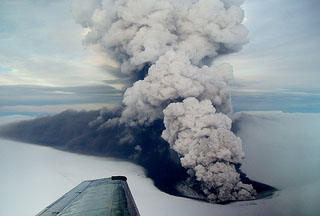Report on Grimsvotn (Iceland) — 6 May-12 May 2015
Smithsonian Institution / US Geological Survey
Weekly Volcanic Activity Report, 6 May-12 May 2015
Managing Editor: Sally Sennert.
Please cite this report as:
Global Volcanism Program, 2015. Report on Grimsvotn (Iceland) (Sennert, S, ed.). Weekly Volcanic Activity Report, 6 May-12 May 2015. Smithsonian Institution and US Geological Survey.
Grimsvotn
Iceland
64.416°N, 17.316°W; summit elev. 1719 m
All times are local (unless otherwise noted)
According to the Icelandic Meteorological Office, a small glacial outburst flood (jökulhlaup) from Grímsvötn's subglacial lake was occurring on 6 May, increasing the water level in the Gígjukvísl River. Electrical conductivity measurements indicated a considerable increase of a geothermal contribution to the river water. Based on information from the Institute of Earth Sciences, the water available for drainage was 0.2-0.3 cubic kilometers, therefore the maximum discharge of the flood was expected to be less than 700 cubic meters per second, occurring towards the middle of the week. Seismic tremor had increased due to the flood and not volcanic activity. The report warned that hydrogen sulfide released from the floodwater as it drains is particularly potent at the river outlet at the ice margin, where concentrations may reach poisonous levels.
Geological Summary. Grímsvötn, Iceland's most frequently active volcano in recent history, lies largely beneath the vast Vatnajökull icecap. The caldera lake is covered by a 200-m-thick ice shelf, and only the southern rim of the 6 x 8 km caldera is exposed. The geothermal area in the caldera causes frequent jökulhlaups (glacier outburst floods) when melting raises the water level high enough to lift its ice dam. Long NE-SW-trending fissure systems extend from the central volcano. The most prominent of these is the noted Laki (Skaftar) fissure, which extends to the SW and produced the world's largest known historical lava flow in 1783. The 15 km3 basaltic Laki lavas were erupted over 7 months from a 27-km-long fissure system. Extensive crop damage and livestock losses caused a severe famine that resulted in the loss of one-fifth of the population of Iceland.

